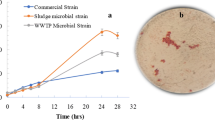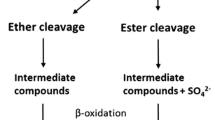Abstract
Polyalcohol ethoxylate (PAE), an anionic surfactant, is the primary component in most laundry and dish wash detergents and is therefore highly loaded in domestic wastewater. Its biodegradation results in the formation of several metabolites and the fate of these metabolites through wastewater treatment plants, graywater recycling processes, and in the environment must be clearly understood. Biodegradation pathways for PAE were investigated in this project with a municipal wastewater microbial consortium. A microtiter-based oxygen sensor system was utilized to determine the preferential use of potential biodegradation products. Results show that while polyethylene glycols (PEGs) were readily degraded by PAE acclimated microorganisms, most of the carboxylic acids tested were not degraded. Biodegradation of PEGs suggests that hydrophobe–hydrophile scission was the dominant pathway for PAE biodegradation in this wastewater community. Ethylene glycol (EG) and diethylene glycol (DEG) were not utilized by microbial populations capable of degrading higher molecular weight EGs. It is possible that EG and DEG may accumulate. The microtiter-based oxygen sensor system was successfully utilized to elucidate information on PAE biodegradation pathways and could be applied to study biodegradation pathways for other important contaminants.









Similar content being viewed by others
References
ATSDR (1997) Toxicological profile for ethylene and propylene glycol. US Departement of Health and Human Services, Public Health Services, Atlanta, GA
Balson T, Felix MSB (1995) Biodegradability of nonionic surfactants. In: Karsa DR (ed) Biodegradability of surfactants. Blackie Academic and Professional, New York, pp 204–229
Brown D (1995) Introduction to surfactant biodegradation. In: Karsa DR, Porter MR (eds) Biodegradability of surfactants. Blackie Academic and Professional, New York, pp 1–27
Cox DP (1978) The biodegradation of polyethylene glycols. Adv Appl Microbiol 23:173–194
Garland JL, Levine LH, Yorio NC, Hummerick M (2004) Response of graywater recycling systems based on hydroponic plant growth of three classes of surfactants. Water Res 38(8):1952–1962
Garland JL, Roberts MS, Levine LH, Mills AL (2003) Community-level physiological profiling using an oxygen-sensitive fluorophore in a microtiter plate. Appl Environ Microbiol 69(5):2994–2998
Kawai F (1987) The biochemistry of degradation of polyethers. Crit Rev Biotechnol 6(3):273–307
Kawai F, Kimura T, Fukaya M, Tani Y, Koichi O, Ueno T, Fukami H (1978) Bacterial oxidation of polyethylene glycol. Appl Environ Microbiol 35(4):679–684
Kawai F, Yamanaka H (1986) Biodegradation of Polyethylene Glycol by Symbiotic Mixed Culture (Obligate Mutualism). Arch Microbiol 146:125–129
Kravetz L (1990) Biodegradation pathways of nonionic ethoxylates. In: Glass JE, Swift G (eds) Agricultural and synthetic polymers. American Chemical Society, Washington, DC, pp 96–109
Lange RK (1999) Surfactants: a practical handbook. Hanser Gardner Publications, Cincinatti
Ogata K, Kawai F, Fukaya M, Tani Y (1975) Isolationof polyethylene glycols-assimable baceteria. J Ferment Technol 53:757
Pearce BA, Heydeman MT (1980) Metabolism of di(ethylene glycol)[2-(2′-hydroxy-ethoxy)ethanol] and other short poly(ethylen glycol)s by gram-negative bacteria. J Gen Microbiol 119:21–27
Steber J, Berger H (1995) Biodegradability of anionic surfactants. In: Karsa DR, Porter MR (eds) Biodegradability of surfactants. Blackie Academic and Professional, New York
Steber J, Wierich P (1985) Metabolites and biodegradation pathways of fatty alcohol ethoxylates in microbial biocenoses of sewage treatment plants. Appl Environ Microbiol 49(3):530–537
Acknowledgments
This research was supported by a grant from NASA through the ALS NSCORT Center, headquartered at Purdue University.
Author information
Authors and Affiliations
Corresponding author
Rights and permissions
About this article
Cite this article
Sharvelle, S.E., Garland, J. & Banks, M.K. Biodegradation of polyalcohol ethoxylate by a wastewater microbial consortium. Biodegradation 19, 215–221 (2008). https://doi.org/10.1007/s10532-007-9128-4
Received:
Accepted:
Published:
Issue Date:
DOI: https://doi.org/10.1007/s10532-007-9128-4




